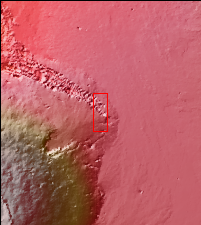
Context imageThe two depression crossing this image are called Pavonis Fossae and are located on the northern lower flank of Pavonis Mons. These linear features are most likely created by a combination of both tectonic and volcanic forces. The top feature has several narrow 'walls' within the depression, indicating a collapse of the roof of an empty lava tube.
Pavonis Mons is the central volcano of the three large Tharsis volcanoes. All three volcanoes form a line located along a tectonic bulge caused by extensional forces in the region. Pavonis Mons is the smallest of the three with a summit of only 14km (8.7 miles).
Orbit Number: 90136 Latitude: 3.50046 Longitude: 249.786 Instrument: VIS Captured: 2022-04-10 02:31
Please see the THEMIS Data Citation Note for details on crediting THEMIS images.
NASA's Jet Propulsion Laboratory manages the 2001 Mars Odyssey mission for NASA's Science Mission Directorate, Washington, D.C. The Thermal Emission Imaging System (THEMIS) was developed by Arizona State University, Tempe, in collaboration with Raytheon Santa Barbara Remote Sensing. The THEMIS investigation is led by Dr. Philip Christensen at Arizona State University. Lockheed Martin Astronautics, Denver, is the prime contractor for the Odyssey project, and developed and built the orbiter. Mission operations are conducted jointly from Lockheed Martin and from JPL, a division of the California Institute of Technology in Pasadena.

